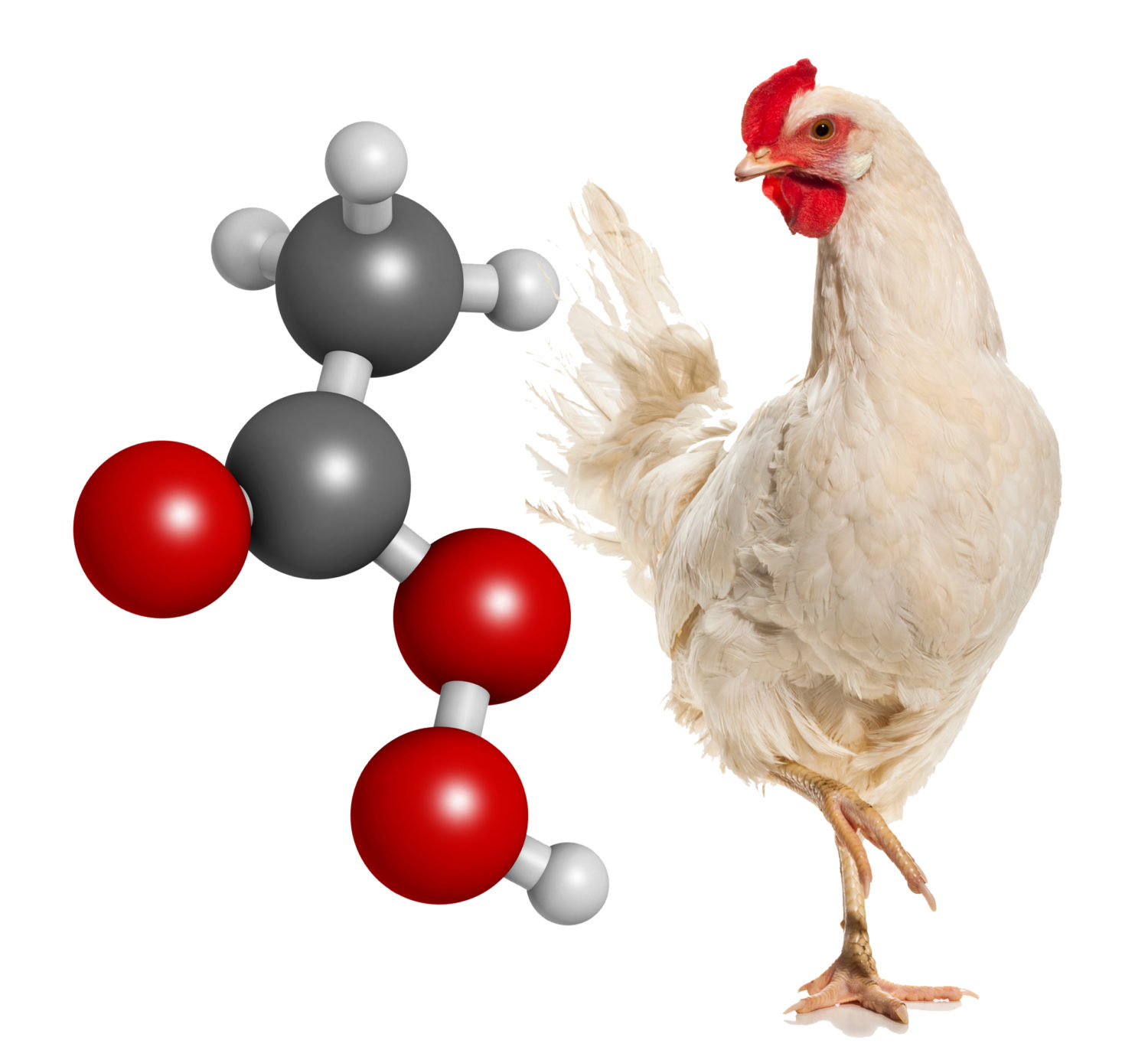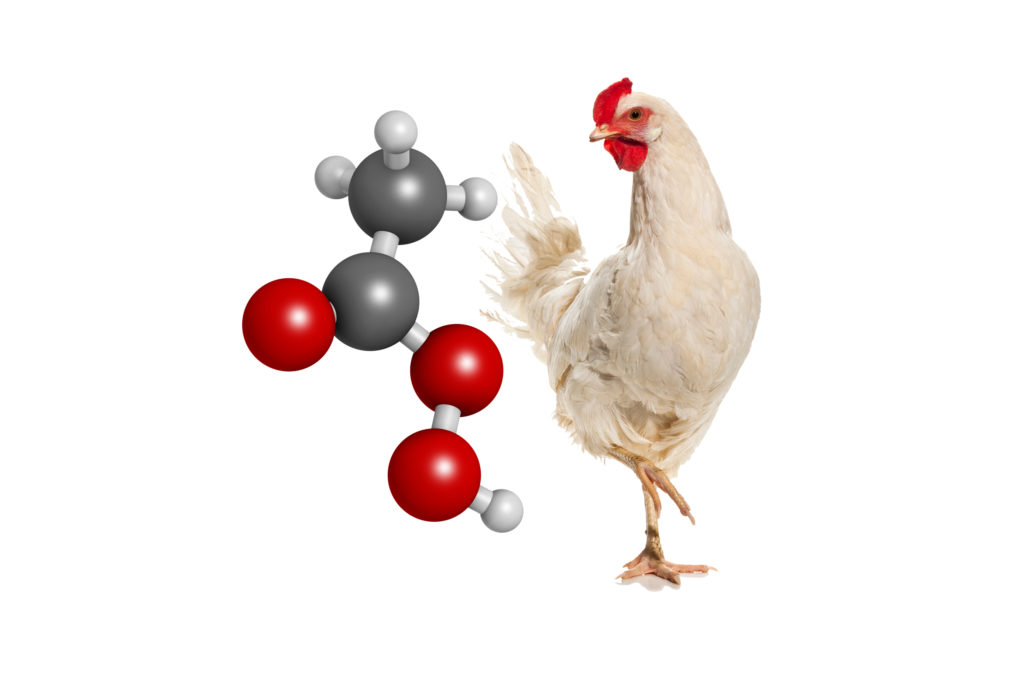
In the modern American chicken ‘processing plant’ (a euphemistic term for the slaughterhouse), the ‘New Poultry Inspection System’, a set of regulations drawn up by the United States Department of Agriculture (USDA) in 2014, allows up to 175 chickens to be killed per line, per minute. Doing the rudimentary math, that’s almost 3 animals per second. And lines operating at these kinds of speeds bring with them dangers to those on both ends of the knife – whether the slaughterer’s knife or that of the eventual diner. Given that ‘processing’ a live animal into shrink-wrapped body parts for our consumption is an inherently messy process, it should come as no surprise that contamination can occur. Let’s be clear: it is not uncommon that blood and fecal material from the chicken will coat parts of the processed flesh and, according to the USDA’s training video on acceptable practices, carcasses can spend time marinating in the ‘fecal soup’ of the chilling pools before being packaged for the consumer.(1) What’s more, as dire as that already is, it is not the whole story in terms of possible contamination. In fact, along with the blood and intestinal matter that may also be sprayed on workers operating the lines, general working conditions and speed of the processes mean that slaughterhouse employees are rarely extended the courtesy of relaxing bathroom breaks. Indeed, documentation exists to support claims that workers even resort to relieving themselves in situ at the line.(2) It takes little imagination to understand that this behavior also has implications in terms of contamination.
And, of course, that kind of contamination offers significant risk to consumer health and safety. Fecal contamination of chicken products regardless of source (avian or human) can lead to the distribution of bacteria such as Shigella, E. coli, Salmonella, Staphylococcus, Listeria, and Campylobacter. In addition, viruses such as Norovirus and Hepatits A can be transmitted from an infected worker to a consumer if the food item comes into contact with contaminated water. Water such as the ‘fecal soup’ we referenced earlier.
… it’s time to turn our attention to the question of contamination control – specifically the use of disinfectants in food production.
While we’re not sure how much information of this nature it would take to lead a hungry diner to turn down that fast food bucket of fried chicken, but fecal contamination certainly does it for us. So, in an attempt to settle our already queasy stomachs, perhaps it’s time to turn our attention to the question of contamination control – specifically the use of disinfectants in food production.
PAA. It may just be the compound that saves us – well, chicken eaters among us anyhow. Peracetic acid (PAA) is the combination of acetic acid – vinegar – and hydrogen peroxide, resulting in a weaker acid than vinegar but one which, if not used at the correct level of dilution, can still be highly corrosive. First registered with the EPA as a disinfectant in 1985, the distinctly vinegary odor of PAA signals a wealth of properties that make it ideally suited to use in the food and beverage industries. Interestingly, it is also a liquid within a liquid and it does not emit noxious fumes by off-gassing, a point to which we will return shortly. Colorless but acrid, anhydrous peracetic acid is highly reactive and effective, and – given its perfect water miscibility – has been used as a bactericide and sporicide for fruit cleaning since the 1950s. It works equally well on both gram-negative and gram-positive bacteria, fungi, and yeasts in treatment times of less than 5 minutes in duration where the contaminants exist at fewer than 100ppm. Across the beverage industry it is widely used for sterilizing bottles and, within a surgical setting, it is also preferred for sterilizing medical and dental equipment – removing surface debris from endoscopes, arthroscopes, and other similar accoutrements. According to Center for Disease Control and Prevention (CDC) data, the exact mechanism by which PAA works is not thoroughly understood but ‘it is thought to function as other oxidizing agents, i.e. it denatures proteins, disrupts cell wall permeability, and oxidizes sulfhydral and sulfur bonds in proteins, enzymes, and other metabolites.’(3)
A slightly mysterious yet highly effective chemical, it would seem.
But let’s return to that pesky issue of the off-gassing. In general terms, the fewer noxious gases circulating in a workplace environment the better. But in terms of calculating the long-term hazards of extended atmospheric exposure – and in taking steps to mitigate them – being unable to detect the presence of PAA is problematic. As Loren Sweatt, Deputy Assistant Secretary of Labor for Occupational Safety and Health, comments in a speech delivered at the National Safety Conference for the Poultry Industry (August 2018) the properties that make PAA highly desirable for use in poultry processing also create ‘challenges in trying to measure atmospheric PAA concentrations or assess worker exposure to the chemical while in use.’(4) Furthermore, in a post published by Professional and Technical Services (PTS), it is noted that:
“Peracetic acid’s safety profile can also be closely correlated to its concentration. The higher the concentration, the worse the safety profile is. For example, an in use solution of PAA of 5% has relatively low oral toxicity at this dilution. However, respiratory issues, including occupational asthma development associated with PAA have been reported. Further, it can strongly sensitize respiratory organs and cause mucus membrane inflammation. Furthermore it is important to be weary of skin and eye exposure as it can cause irritation. Overall, peracetic acid proper care needs to be taken in its use.”(5)
So PAA may be absorbed by inhalation, through the skin, and by ingestion, and can cause a sensitization of respiratory organs and induce occupational asthma. Yet, because it is hard to detect using conventional air quality management equipment, no permissible exposure level (PEL) can be calculated. And having no PEL for an acid used so widely and so effectively is a problem both for the Occupational Health and Safety Administration (OSHA) and for potential customers overseas.
Take, for instance, US poultry exports to the European Union. Although EU regulations allow for poultry imports from the U.S., certain conditions must be satisfied, including the use of anti-microbial treatments at the processing level. According to the Food Safety and Inspection Service (FSIS), a program of the USDA, poultry meats are ‘eligible for export to the European Union provided that the production systems used to produce them and all pertinent EU requirements are met.’(6) However, one of the stipulations reads as follows:
“With the exception of lactic acid solutions used on bovine or bison carcasses, antimicrobial treatments (for example, hyperchlorination, TSP, citric or ascorbic acids, etc.) are not allowed for treatment of red meat or poultry carcasses, parts or viscera. Only the application of water, recycled hot water or steam is permitted. Use of recycled hot water is only permitted when integrated into the facilities HACCP system and applied consistently with Commission Regulation (EU) 2015/1474.”(7)
So, in the broadest terms, while European Union authorities do recognize that PAA is safe, export/import requirements stipulate that its use as an anti-microbial renders products ineligible for import. And the reason for this? According to an article by Richard Warburton in Food Safety Magazine, ‘[s]ome research has found that chlorine/hypochlorite can react with fats and proteins to form various chlorinated compounds some which are potentially carcinogenic. Even treatment of vegetables such as bean sprouts and cabbages with sodium hypochlorite were found to produce chloroform (CHCl3) a known carcinogen.’(8)
We’re betting you won’t be surprised to know that it is a star of the cleanroom environment.
Carcinogens and chloroform – maybe you’re already crossing chicken off the menu, but where else is PAA used? We’re betting you won’t be surprised to know that it is a star of the cleanroom environment. As a high level sterilant, PAA is known to be effective as a sporicide but, in addition, is also tuberculocidal, virucidal, and bactericidal which, for some, makes it indispensible in contamination-controlled environments. What’s more, the preparation achieves excellent disinfection in just 15 minutes, with sterilization at 180 minutes, yet is safe to use even on food contact surfaces (per 21 CFR 178.1010) and surfaces that are sensitive to scratches. Easily dispensed in liquid form, PAA does not add to conductivity, creates no byproducts of disinfection, and requires no Risk Management Plan to be in place. Moreover, when used after a detergent to remove soils from a surface, PAA can be applied with a wiper and acts without leaving a residue.
But that one thorny problem of the risks to human health posed by extended exposure does remain. And it’s an issue that can only be addressed on multiple levels – from governmental oversight to personal diligence and care. So let’s examine what cleanroom technician can do to minimize their exposure to the chemical.
Along with wearing any and all personal protective equipment (PPE), those who handle PAA are strongly encouraged to store it in a cool environment prior to using the solution. Ideally, this environment should be out of direct sunlight as the drums in which the PAA is stored may heat up, causing a gaseous expansion that the membranes within the venting systems cannot accommodate. And use of the correct storage drums is critical to worker safety: concentrated PAA should never be poured into any tank or container not made of compatible materials and strictly dedicated for use with the chemical.
And what is the protocol for re-using or re-storing excess PAA? Unlike other chemicals, given its potential for decomposition PAA should never be returned to the original container once it has been poured out. The breakdown of PAA into acetic acid and hydrogen peroxide is an exothermic reaction, which produces both oxygen and heat – the perfect recipe for an explosion. In fact, according to CDC guidelines, PAA may ‘explosively decompose on shock, friction, or concussion. […] and reacts violently with combustible and reducing materials.’(9) Always dispose of excess PAA in a safe and environmentally-aware manner.
In summary, what appeared at the top of the article to be a comparatively simple chemical – a combination of acetic acid and hydrogen peroxide – has, upon closer analysis, metamorphosed into a complex and nuanced tool that, while effective in terms of its bactericidal qualities, is neither a good cleaning agent nor harmless to those who use it in their work. In 2014, the American Conference of Government Industrial Hygienists (ACGIH) succeeded in agreeing upon a new guideline threshold limit for exposure – a Short-Term Exposure Limit (STEL) – of 0.04ppm in a time-weighted average (TWA) of 15 minutes. Amid much discussion and controversy, this STEL TWA was theoretically useful insofar as a hard exposure limit was assigned but, in practical terms, this threshold is helpful only if real time measurements of environmental/atmospheric PAA can be taken.
By contrast, hydrogen peroxide – which has long been fêted for its ability to quickly kill bacteria in wounds yet decomposes elegantly to gaseous oxygen and water – wields an equally potent oxidizing power without the associated health concerns. And if today’s discussion has piqued your curiosity about this alternative to PAA and you’re interested in a refresher on H2O2, may we strongly recommend you review our own Learning Center exploration of the solution, ‘Disinfection of Cleanroom Surfaces with Hydrogen Peroxide.’(10) It’s guaranteed to ‘clean up’ any lingering confusion or questions on the issue…
PAA or H2O2 – do you have a preference? In terms of cleanroom surface biocides, do you consider one to be superior to the other? How do you use these agents in your contamination-controlled environment? We’d love to hear from you!
References:
- Tom McDougal. Poultry Slaughter Procedures. U.S. Department of Agriculture Food Safety and Inspection Service Office of Field Operations; 1998.
- https://www.washingtonpost.com/news/wonk/wp/2016/05/11/i-had-to-wear-pampers-many-poultry-industry-workers-allegedly-cant-even-take-bathroom-breaks/?utm_term=.c1336a7cb55a
- https://www.cdc.gov/infectioncontrol/guidelines/disinfection/sterilization/peracetic-acid.html
- https://www.osha.gov/news/speeches/08132018
- http://talkcleantome.blogspot.com/2012/11/disinfectant-9-peracetic-acid-weak-acid.html
- https://www.fsis.usda.gov/wps/portal/fsis/topics/international-affairs/exporting-products/export-library-requirements-by-country/European-Union
- ibid
- https://www.foodsafetymagazine.com/signature-series/peracetic-acid-in-the-fresh-food-industry/
- https://www.cdc.gov/niosh/ipcsneng/neng1031.html
- https://www.berkshire.com/learning-center/disinfection-hydrogen-peroxide/

